Fulton County Pennsylvania
© David W. Cathell 2006
Note!-All Links Require the Use of Your Browser's 'Back' Function
This page was at one time connected to other pages served by Geocities, and subsequently Yahoo.. Yahoo started charging and in the process, made changes that destroyed those pages. That is why many links do not work. Sorry !
Reichley Brothers Railroad
Wells Valley

Colonel Schlatter's southern Pennsylvania route through Wells Valley, Fulton County Pennsylvania
Titled"Map exhibiting that portion of the State of Pennsylvania traversed by the surveys for a continuous rail road from Harrisburg to Pittsburg(h) made under the direction of Charles L. Schlatter, c.e. in the year 1839 and 1840. Drawn by Charles Cramer."

1933 topo showing the northern area of the Reichley Brothers RR. The Reichley's railroad is not shown, although the station of Reichley is on the HBTM RR, atop the mountain. How the railroad got from the mountaintop to Slabtown is unclear to this author; a likely route is not apparent on any map I have studied. It would have been steep, safe to say. Slabtown, the location of the sawmill is the collection of building to the northeast of Duvall Ridge and south of the 1124 elevation indication.
As with most identified early rail surveys, a rail road eventually crossed Rays Hill into Wells Valley, Colonel Schlatter's connection to the Juniata on his southern Pennsylvania's rail survey shown on the map above. In this case, it was Reichley Brother's, the longest of the Fulton County logging railroads. Built in 1909 and 1910, the logging railroad operated until about 1926 on logs, mine props and finished lumber. It is also reported that farm products and freight were carried, but apparently as a casual sideline and not a common carrier (Reichley's continued logging after the railroad closed to about 1930). Over the years, Reichley's extended the logging road south along Rays Hill all the way to Crystal Spring, about a 30 mile logging railroad. Crystal Spring was along a surveyed but never used B&O railroute named the Potomac and Allegheny Railroad that provided a link from Hancock Maryland to Mt. Dallas Pennsylvania where the B&O owned the South Pennsylvania Railroad right of way to the west.
Reichley's logging road left the Huntingdon & Broad Top (H & B T M) at Sandy Run (Hopewell) in Bedford County and steeply climbed southeast with a switchback to almost the top of the mountain before switchbacking again down into Wells Valley. Referring to the Schlatter map above, note that the 1839 survey had the railroad using Wishart Gap to access "Groundhog Valley" (today's Sherman Valley) for a good grade down to the Juniata at Cypher. On the east side, the Schlatter survey used Sidling Hill Creek to cross both the formiable Sideling Hill and Ray's Hill ridges at the early standard of 60 feet to the mile. My speculation is that there would have been a tunnel at about 1400 foot elevation at the summit.
A definitive history of Reichley's operation is provided by B.F.G. Kline, Jr. in Pitch Pine and Prop Timber. This history provides obstacles surmounted by Reichley's and their Climax locomotives. Kline indicates that Reichley's built their 42" inch gauge logging railroad all the way from Hopewell to Wells Valley and beyond. Only in 1922 did the the standard gauge H & B T M dual gauge the steep line to reach the remote Garlick Mine located on the Bedford./Fulton County line. According to Kline's account, in 1922 the H & B T M made the track dual gauge from Sandy Run past a station called Reichley to the Garlick coal mine . Although long lived, Reichley's Wells Valley operations were never large and it seems a stretch for such an operation to build a newly constructed line all the way from Hopewell and then use the steepest route in the process (note that Schlatter's route would have built up the Sherman Valley from Cypher; onsite inspection shows an extreme elevation difference between the two routes). It seems more likely that the steep Sandy Run branch would had been built earlier for H & B T M to tap coal mines along Sandy Run and the Reichley's could add a narrow gauge on the end. Kline, however, did a lot of research including with people who were involved at the time;, so his account should be correct, Reichley's built the Sandy Run branch and only later did the H & B T M take it over.
Hopewell
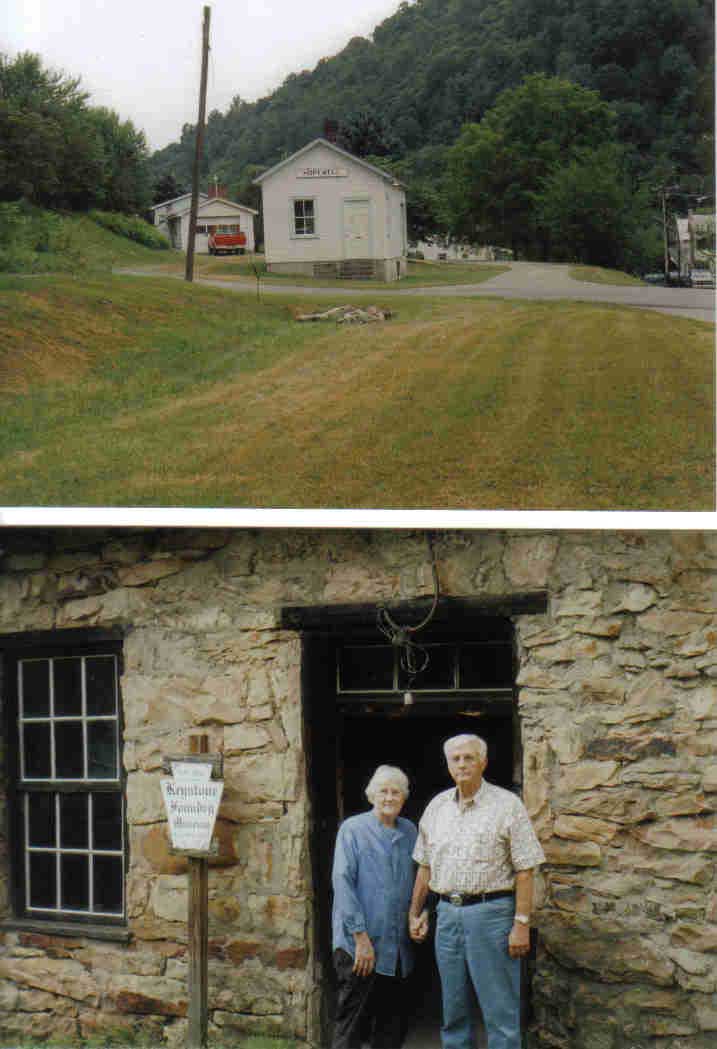 On the Raystown Branch, Hopewell, Bedford County, has at least two H & B T M structures, the depot (top)and Keystone Foundry and Machine Works (bottom). The machine shop and foundry was opened in 1857 as a repair facility for the railroad and operated (by various owners) until the midst of the depression when it closed one day never to open. When donated to the Senior Citizens in 1991, the shop was just as it closed in 1935 with not only machines, but also tools and patterns in place. Maintained as a museum, this historical treasure is supported by the time of the volunteers as shown in the photo whose numbers are dwindling. The lady in the photo, Emily Dubner, spent her early years in Garlick but did not recall the Reichley operation. This museum is a hidden gem within easy driving distance from Raystown Lake or East Broad Top RR. It is open on weekends from 1-4PM during the summer. For more info, call 814.928.5111.
On the Raystown Branch, Hopewell, Bedford County, has at least two H & B T M structures, the depot (top)and Keystone Foundry and Machine Works (bottom). The machine shop and foundry was opened in 1857 as a repair facility for the railroad and operated (by various owners) until the midst of the depression when it closed one day never to open. When donated to the Senior Citizens in 1991, the shop was just as it closed in 1935 with not only machines, but also tools and patterns in place. Maintained as a museum, this historical treasure is supported by the time of the volunteers as shown in the photo whose numbers are dwindling. The lady in the photo, Emily Dubner, spent her early years in Garlick but did not recall the Reichley operation. This museum is a hidden gem within easy driving distance from Raystown Lake or East Broad Top RR. It is open on weekends from 1-4PM during the summer. For more info, call 814.928.5111.
Wells Tannery
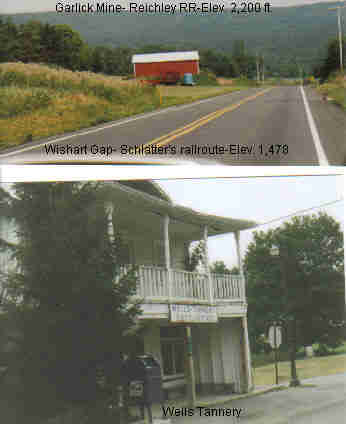 Top photo shows the elevation difference between Colonel Schlatter's Wishart Gap route and Reichley logging railroad on the side of Rays Hill. Reichley's were mine prop merchants with long experience (before Wells Valley, they had extensive operations in Mifflin and Centre counties; steep grades did not daunt them or their tough Climax locomotives. Perhaps another reason that they were on the side of the mountain could be that they were also logging it. Bottom photo show the existing village of Well's Tannery which is surrounded by farmland. As the name indicate, it was the location of an earlier tannery served by wagon transportation of bark.
Top photo shows the elevation difference between Colonel Schlatter's Wishart Gap route and Reichley logging railroad on the side of Rays Hill. Reichley's were mine prop merchants with long experience (before Wells Valley, they had extensive operations in Mifflin and Centre counties; steep grades did not daunt them or their tough Climax locomotives. Perhaps another reason that they were on the side of the mountain could be that they were also logging it. Bottom photo show the existing village of Well's Tannery which is surrounded by farmland. As the name indicate, it was the location of an earlier tannery served by wagon transportation of bark.
Reichley Brothers Sawmill
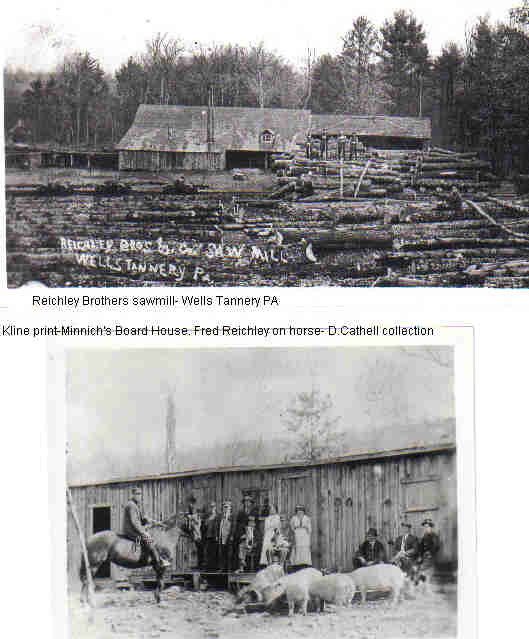 Top photo shows the Reichley sawmill , a mile or so from Wells Tannery in a location that was known as Slabtown. "Slabtown" was a generic location name around sawmills and timber camps, so named because of the hasty manufacture of buildings from rough cut lumber. The sawmill equipment was brought from Reichley's much larger sawmill at Milroy, Centre Couny. At Wells Tanney, the mill is housed in a much more modest structure associated with operators mostly cutting mine props. The photo presents another quandary of the Brother's operation. Mine props were apparently unloaded on the uphill side of the railroad in the foreground of the photo. This means that they would have to be eventually manually reloaded onto the log cars and hauled up the mountain to either Reichley or Hopewell where they would have to be again unloaded and reloaded onto standard gauge gondolas to be hauled to the coal fields. Mine props were sold by the ton and other Pennsylvania mine prop operations usually would not bear such labor intensive transloading, but somehow the Reichley's did it for years.
Top photo shows the Reichley sawmill , a mile or so from Wells Tannery in a location that was known as Slabtown. "Slabtown" was a generic location name around sawmills and timber camps, so named because of the hasty manufacture of buildings from rough cut lumber. The sawmill equipment was brought from Reichley's much larger sawmill at Milroy, Centre Couny. At Wells Tanney, the mill is housed in a much more modest structure associated with operators mostly cutting mine props. The photo presents another quandary of the Brother's operation. Mine props were apparently unloaded on the uphill side of the railroad in the foreground of the photo. This means that they would have to be eventually manually reloaded onto the log cars and hauled up the mountain to either Reichley or Hopewell where they would have to be again unloaded and reloaded onto standard gauge gondolas to be hauled to the coal fields. Mine props were sold by the ton and other Pennsylvania mine prop operations usually would not bear such labor intensive transloading, but somehow the Reichley's did it for years.
On the downhill side, sawlogs were unloaded and eventually moved into the mill's forebay by hand; this mill had no labor saving mill pond. Note the trussed roof of the forebay, allowing a long structure without intermediate supports to block the logs being rolled in lenghtwise. Kline got this photo from Lena Chamberlain.
The bottom photo shows the Minnich Boarding House. Fred Reichley is on the horse, according to the inscription on the back of the photo; the book, however, say the man was Henry Minnich. A casual glance give the impression of the backward woodhick cliche, however closer inspection reveals most of the men in suits and the ladies neat in Sunday whites. The hogs were a camp efficiency, recycling food scraps and spilled horse feed when not roaming nearby woods to feed themselves on chestnuts and acorns. When needed, they became a main ingredient for a camp staple, buckwheat cakes and sausage. An advantage of hard logging labor was the ability to eat huge meals without gaining weight. Unknown photograper, Kline print no. LW-336, D. Cathell collection.
The above paragraph was written in 2006 and you might gather that it was a lot of speculation on this author's part. I recently (2011) heard from Mr. Joseph Duvall that his grandfather John Duvall was associated with the Reichley operation in Fulton County as the blacksmith and further "when I saw the pic of the man on a horse and the pigs and several others around, my recollection is that my family used to have a picture like that and it was always told that the man on the horse was my gradfather. The story goes that he raised hogs on his farm which was about 3/4 mi. away and when they were ready to butcher, he's drive them to Slabtown, sell them to Mr. Reightley for his sawmill laborers. Grandpa would then butcher the hogs, and dress them out and get paid for that also.
I'm not so sure but what that may be what you're seeing in that one pic.....him just having arrived in Slabtown with his hogs and they are getting their first "Slabtown meal"! I Don't know and as I say, at this time, it really doesn't make much difference.
One of my aunts, Ruth Duvall, daugther of John, used to tell how as kids, some of them would have to drive grandpa to Slabtown and he'd stay there for the week and then on Friday at the proper time, they'd take the mules and the wagon and go back to bring him home.
During the week, while grandpa was away working, the older kids would do the farm work and keep things at home going. By taking him , they would have the mules and wagon during the week to do chores around the farm.
One time when they were on their way down to Slabtown to get Grandpa, something spooked the mules and they began to run as fast as they could. Aunt Ruth tells that there was two of her siblings along and all three held onto the reins as hard as they could but the mules never slowed down till they got to Slabtown. Someone heard them coming (she always told who it was) somehow Grandpa was alerted and he was able to get them stopped. I guess the kids got a good dressing down for whatever they had supposedly done to get the mules startled and grandpa never left them drive him to work after that. He bought a horse......it may have been the one in the pic.....and rode it to work so the mules and wagon could stay at home.
Actually, I used to hear stories about Slabtown and the sawmill and a lot more till I just didn't pay any attention any more. Now I wish I would have taken some interest. Grandpa & Levi Johnson were best of friends and they really used to tell the stories!
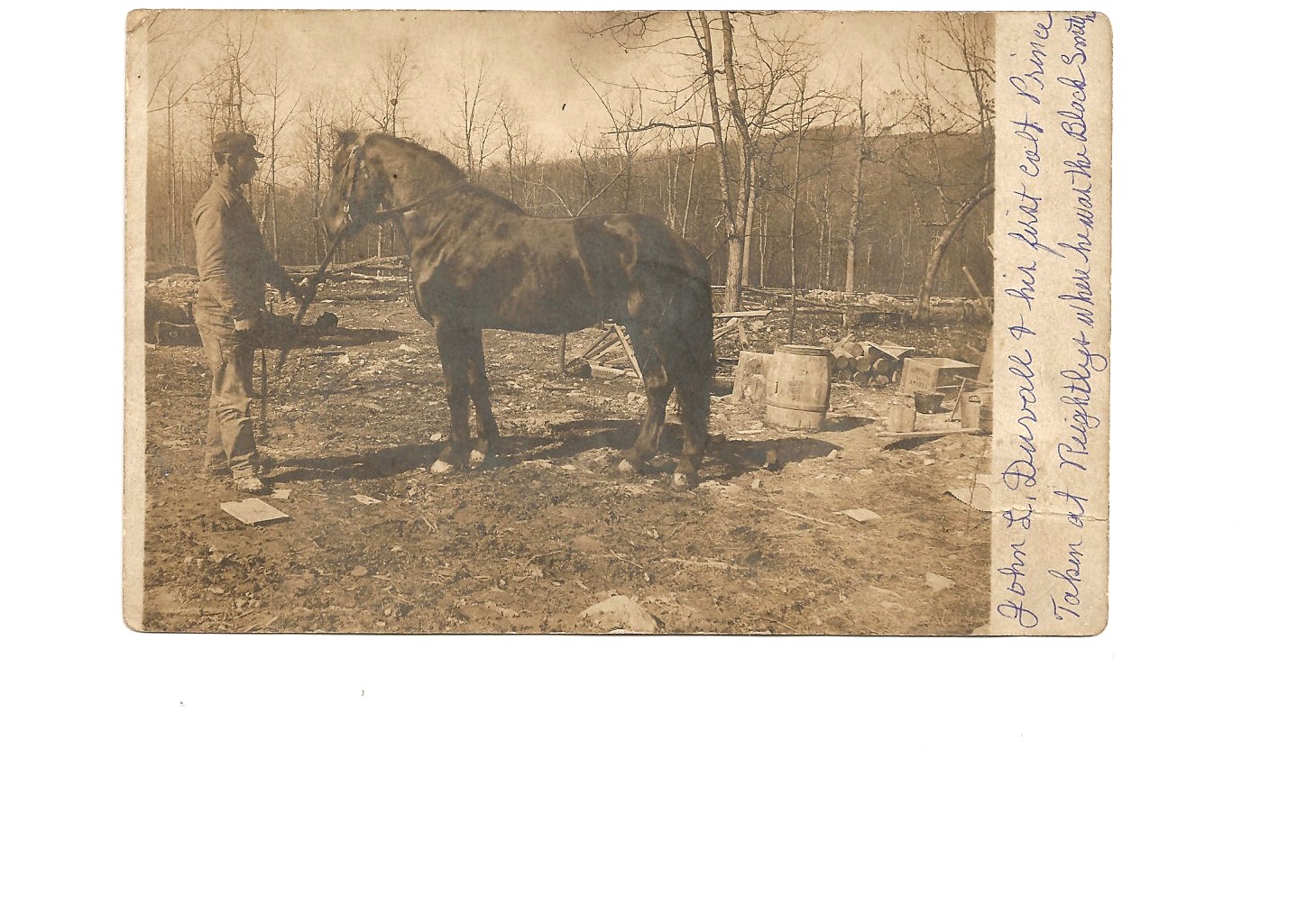 John L. Duvall, blacksmith and farmer, Wells Valley PA
John L. Duvall, blacksmith and farmer, Wells Valley PA
Enid
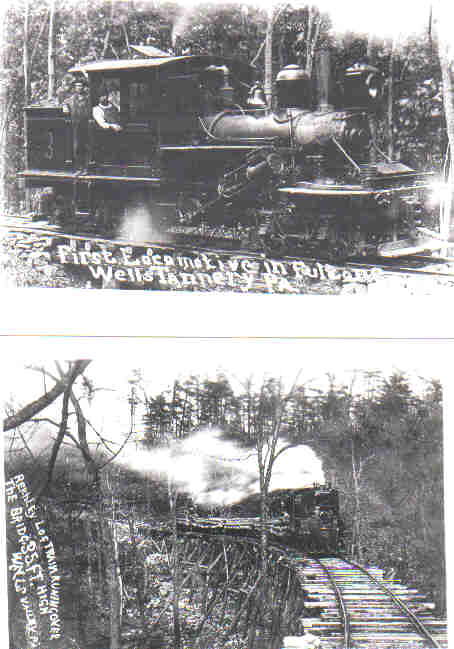 At the sawmill, one line went to the north to Enid. The top photo is captioned "First Locomotive in Fulton Co." which was not the actually true, but it certainly was one of the finest. Construction Number 373, 20 ton No. 3 was built for Reichley Brothers and Company by Climax in 1903 while Reichley's were cutting in Centre County. After the closing of that operation, it spent the rest of its career in Fulton County.
At the sawmill, one line went to the north to Enid. The top photo is captioned "First Locomotive in Fulton Co." which was not the actually true, but it certainly was one of the finest. Construction Number 373, 20 ton No. 3 was built for Reichley Brothers and Company by Climax in 1903 while Reichley's were cutting in Centre County. After the closing of that operation, it spent the rest of its career in Fulton County.
Bottom photo shows "Big Tressle" on the flank of Sidling Hill near Enid. Reported by the photographer to be 35 ft. high. A equally spindly,but lower tressle nearby was named "Little Tressle". Both are example of the balance required by the self trained logging civil engineers; build just heavy enough to suffice for the months needed to log out an area. Reichley workmen reported that log trains crossed this tressle very slowly. the photo, however, slows five loaded cars and at least ten people in the photo. Kline credits the owner of the tressle photo to Harrison Horton.
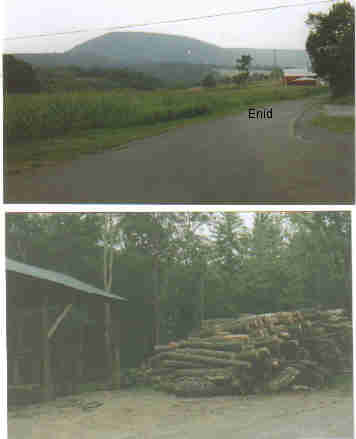 Top photo is looking northwest at Enid. Note again the elevation of Rays Hill to the right compared to the Wishart Gap to the left
Top photo is looking northwest at Enid. Note again the elevation of Rays Hill to the right compared to the Wishart Gap to the left
Timber continues to be produced in Wells Valley. Here smaller varieties are manufactured into firewood near Enid, nearby the same company had a log truck loaded with saw logs.
Oregon and South
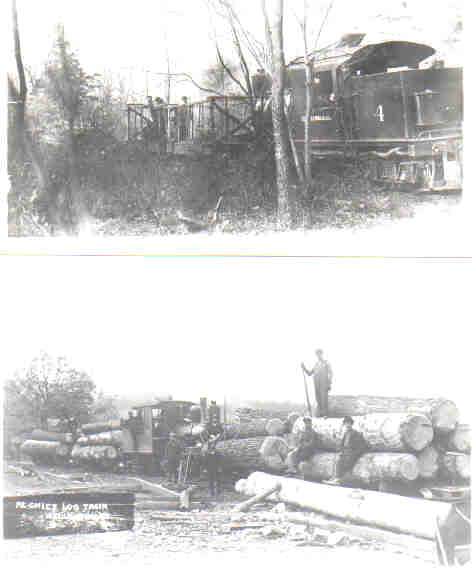 Back at the sawmill, another line went to the south, eventually to Crystal Spring. The top photo shows Climax C.N.1305 25 ton Climax, the last Reichley Brothers locomotive and the only one bought specifically for Fulton County operations. It is shown here easily pulling some cars set up for bark transportation. Mr. Harry Dodson provided the photo to Kline. Kline phoneC-372-a. Print in Cathell collection.
Back at the sawmill, another line went to the south, eventually to Crystal Spring. The top photo shows Climax C.N.1305 25 ton Climax, the last Reichley Brothers locomotive and the only one bought specifically for Fulton County operations. It is shown here easily pulling some cars set up for bark transportation. Mr. Harry Dodson provided the photo to Kline. Kline phoneC-372-a. Print in Cathell collection.
The bottom photo shows a load of fine saw logs hauled by No. 3. The arrangement of the locomotive in the middle of the train allowed a heavy trained to be split in half and "doubled" up steeper grades.
From Oregon Creek, the grade south climbed the flank of Big Wood Ridge, crossed Rt 30 at Old Mountain House and descended into the Little Brush Creek watershed to Crystal Springs. Unknown professional photographer, obtained by Kline from Mrs. Grant Reichley. Kline photo number C-37I-U, negative 373. Cathell collection. 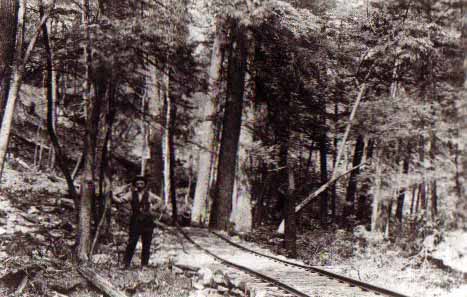 At Beaverdam Pond another branch went east up Sideling Hill with logging in Big Fill and Poplar Hollows, in the process using part of the abandoned South Penn Railroad grade. The longest branch followed Wooden Bridge Creek for two miles. The photo above shows this branch along Wooden Bridge Cree ending abruptly with Anthony Reichley marking the spot.
At Beaverdam Pond another branch went east up Sideling Hill with logging in Big Fill and Poplar Hollows, in the process using part of the abandoned South Penn Railroad grade. The longest branch followed Wooden Bridge Creek for two miles. The photo above shows this branch along Wooden Bridge Cree ending abruptly with Anthony Reichley marking the spot.
Men Associated with Reichley Brothers Operations in Wells Valley, Fulton County, Pennsylvania
Frederick J. Reichley
Anthony J. Reichley
Murray Romig
Buzzy Peters
Henry Wingart
John Steiger
Bert Heinish
James Chamberlain
James Davenport
Elmer Clevanger
Foster Straight
Harry Dodson
Clarence Dodson
Abe Burkett
Albert Deshong
Levi Johnson
James Hanna
Shird Fesler
Matthew Corbin
John Corbin
Clyde Warsing
Ernest Sprowl
Levi Chamberlain
John Chamberlain
John O Chamberlain
Forest Chamberlain
Oscar Horton
"Daddy" Frank Horton
John H.Horton
John T. "Booser" Horton
Ross Swope
Charles Everetts
Ray Deshong
Edward Bainey
Ernest Sprowl
George Sprowl
Lee Sprowl
William Sprowl
Sherman Amick
Billy Bonsel
John L. Duvall, blacksmith (1)
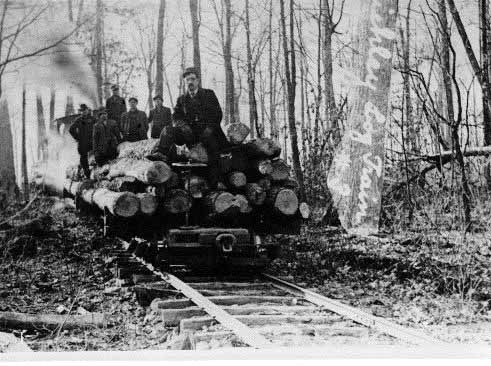 Fred Reichley and some of the Fulton County men who worked the longest logging railroad in Fulton County
Fred Reichley and some of the Fulton County men who worked the longest logging railroad in Fulton County
Bibliography
Kline,Jr, Benjamin F. G.,Pitch Pine and Prop Timber,Book No. 1 in the series Logging Railroad Era of Lumbering in Pennsylvania, self published by the author, reprinted by Friends of the Railroad Museum of Pennsylvania, (c)1999
(1)John L. Duvall was among those associated with the mill. Grandpa was the blacksmith for Reightleys and worked there for several years. The RR spur which ended in Poplar Hollow crossed our property from Joseph J. Duvall, September 2011.











